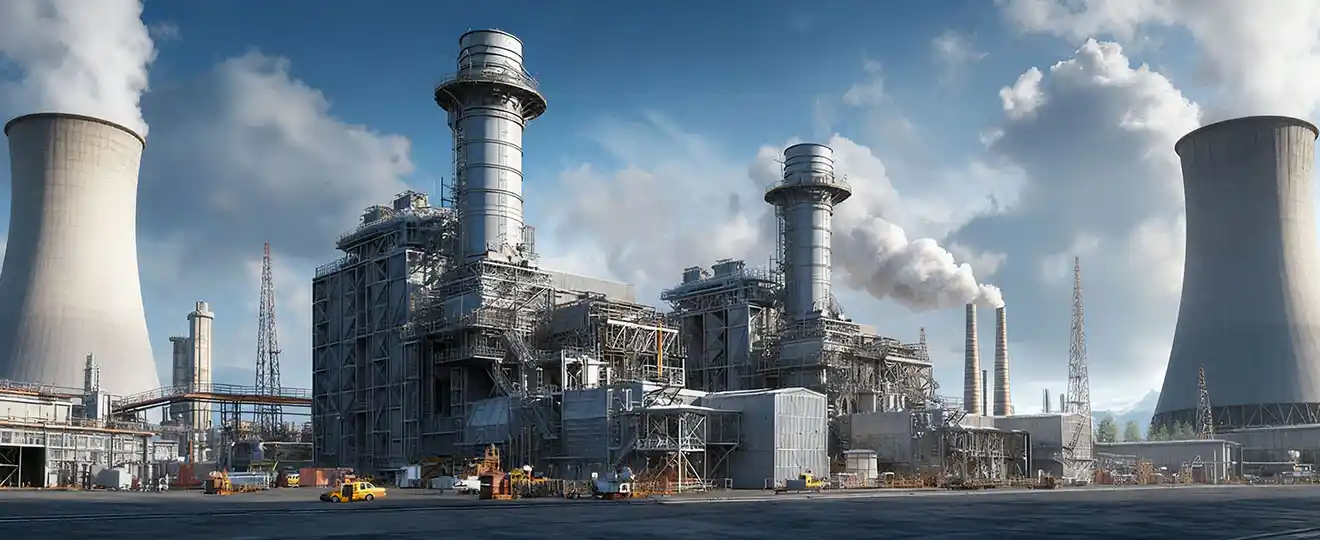
A hot air boiler is a thermal energy device that transfers heat from fuel combustion to air to generate clean hot air. This system typically consists of a boiler, industrial burner, heat exchanger, fan, and control system. It is widely used in industries such as chemical, food, pharmaceutical, textile, metallurgy, and building materials, primarily for material drying, workshop heating, and process heating. Its core feature is indirect heating through a heat exchanger, ensuring clean, pollution-free hot air output. It also offers advantages such as high efficiency, energy saving, and intelligent control.
The hot air boiler process primarily involves three stages: fuel combustion, heat transfer, and hot air output.
Fuel Combustion
The fuel (coal, natural gas, biomass, etc.) is mixed with air in the combustion chamber and ignited, producing high-temperature flue gas (typically 800-1000°C).
During the combustion process, the air-to-coal ratio or gas supply is adjusted to ensure complete combustion and reduce pollutant emissions.
Heat Transfer
Direct Heating: High-temperature flue gas is directly mixed with air, achieving a thermal efficiency exceeding 95%. However, the hot air contains combustion exhaust gases and is only suitable for applications with low air quality requirements (such as ore drying).
Indirect Heating: The flue gas transfers heat to the air through a heat exchanger (tubular or plate). This results in highly clean hot air and is suitable for industries such as food and pharmaceuticals. The use of multi-head spiral grooved plate heat exchange technology and turbulent flow principles enhances heat transfer, with a thermal efficiency typically reaching 80%-92%. Hot Air Output
The heated air is delivered to the target device via a fan. The temperature can be adjusted via a control system, covering low (60-150°C), medium (200-300°C), and high (400-600°C).
The hot air boiler is primarily composed of the following core components:
|
System |
Key Components |
Function |
|
Combustion System |
Combustion chamber, burner, fuel supply device |
Achieve efficient fuel combustion and generate high-temperature flue gas |
|
Heat Exchange System |
Tubular/plate heat exchangers, finned tubes |
Transfer heat to the air to ensure clean hot air |
|
Air Supply System |
Blowers, induced draft fans, air ducts |
Provides cool air and delivers hot air to target equipment |
|
Control System |
PLC controller, temperature sensor, pressure monitoring device |
Automatically adjust combustion parameters to maintain stable hot air temperature (±5°C) |
|
Smoke Exhaust System |
Chimney, dust collector |
Emit flue gas and reduce dust pollution |
|
Type |
Fuel |
Thermal Efficiency |
Advantages |
Applicable Scenarios |
|
Coal-fired hot air stove |
Bituminous coal, anthracite |
70%~85% |
Low fuel cost, suitable for large-scale heating |
Metallurgy and building materials drying |
|
Gas hot air furnace |
Natural gas, liquefied gas |
90%~98% |
Clean and environmentally friendly, with a high degree of automation |
Food processing, pharmaceutical drying |
|
Biomass hot air stove |
Wood chips, rice husks, pellet fuel |
75%~85% |
Renewable energy, low carbon emissions |
Agricultural drying, biomass power plants |
|
Oil-fired hot air furnace |
Diesel, heavy oil |
85%~92% |
High calorific value, suitable for areas without gas supply |
Temporary heating, mobile heating equipment |
Classification by Structural Form
Top-Fired Hot Air Furnaces
Catenary Dome Design: Utilizes multi-layered, high-swirl burners, achieving nitrogen oxide emissions below 50 ppm and air temperatures exceeding 1250°C.
Four-Stage Structure: Optimizes furnace shell stress, eliminates cracking issues associated with traditional furnace shells, and extends service life to over 20,000 hours.
Horizontal/Vertical Hot Air Furnaces
Horizontal: Offers a large footprint and a wide heat exchange area, suitable for medium- and large-scale industrial applications.
Vertical: Compact and easy to install, suitable for small- and medium-sized heating needs (e.g., the RFL series vertical cylindrical hot air furnaces).
|
Parameter |
Explanation |
Typical Range |
|
Output Thermal Power |
Heat provided per unit time |
0.7~100 MW |
|
Hot Air Temperature |
Outlet hot air temperature |
60~600℃ |
|
Fuel Consumption |
Hourly fuel consumption |
Coal: 10~1500 kg/h, gas: 5~500 m³/h |
|
Thermal Efficiency |
Ratio of available heat to total heat of fuel |
70%~98% |
|
Air Volume |
Hot air output per hour |
500~50000 m³/h |
Selection Considerations
Determine heat requirements: Calculate the required heat output and temperature based on the heating area and material moisture content.
Fuel compatibility: Prioritize local, inexpensive fuels (e.g., biomass furnaces in biomass-rich areas).
Environmental protection requirements: Select low-nitrogen burners (e.g., gas furnaces with NOx emissions <30mg/m³) in areas with high environmental protection requirements.
Automation level: For continuous production, it is recommended to equip the system with a PLC control system to enable unmanned operation.
Take every customer request seriously.

Shuxin
Electromechanical
+86 15516359168
shuxin@sxburner.com
Room 504, Building 11, Wuzhou International Industrial Expo City, Old National Highway 310, Xigong District, Luoyang City, Henan Province
+86 15516359168
shuxin@sxburner.com
Room 504, Building 11, Wuzhou International Industrial Expo City, Old National Highway 310, Xigong District, Luoyang City, Henan Province